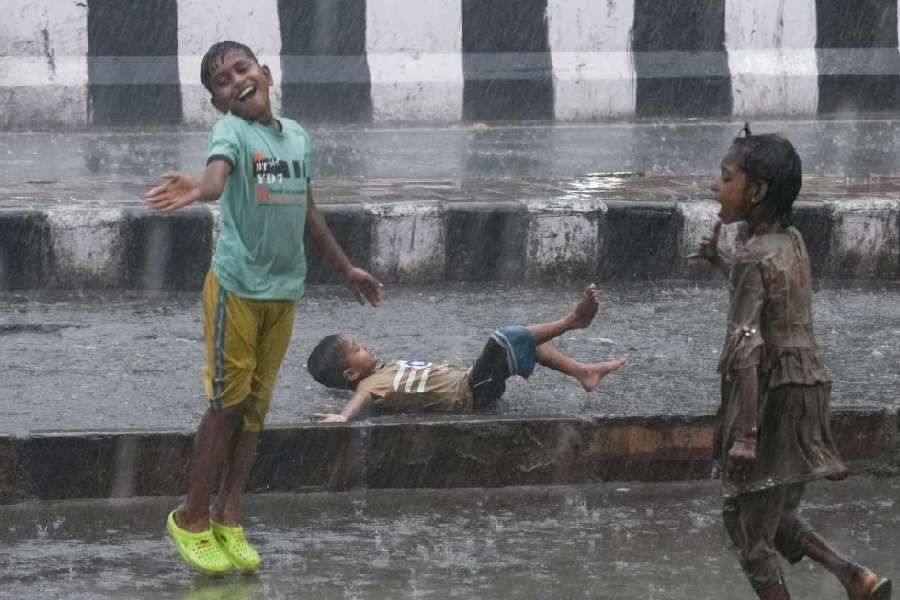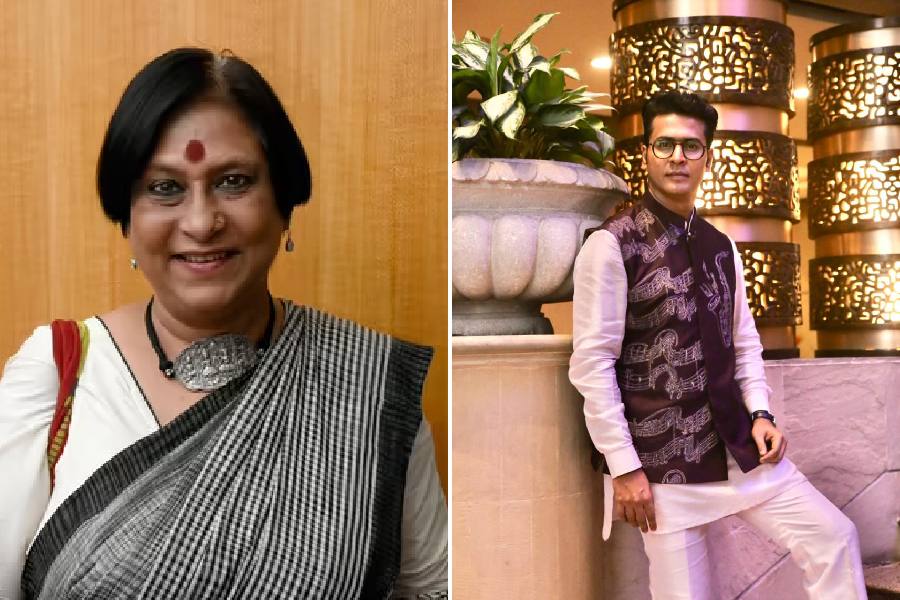|
|
Mullally, Cork, Lewis. The southpaw plays a few balls quite confidently, leaving, middling in a style-dekhachhi kind of way, obviously flattering to deceive. Tendu looks scratchy but he’ll settle again… oh damn, no he won’t! Chris Lewis produces the ball of the series and we can hear the rattle of the stumps from where we sit. The dry snacks turn to ashes in our mouths. Somehow, my Edengaadenz paaink comes out: “Kon-no bepaar na! Tui, ______, maatha nichu rekhe jaast khele jaa!” “No matter! You ___, you just keep your head down and play!” Lords is not that small but compared to Eden, it’s silent as an empty sound-studio. The lefty’s helmet snaps around, he’s clearly heard me. Azhar stalks in, the Bongo plays a couple of nice shots, even strolls a couple of runs like he’s batting on 190, odd contrast with Azhar doing his usual loping sprint. Bongo hits a four, actually nice cover drive. They are clearly getting him to expand beyond his capabilities. But it’s Azhar who snicks behind. Azhar stalks out, crossing the other debut-bakra as he goes. Forget this beer nonsense, where’s that rum?
Will this new guy last long enough to give all-Bengal a half-century? I call out again, Bongo pays attention to my advice and keeps his eye on the ball for several deliveries. The quiet, glorified tail-ender takes guard again. No one remembers what he did with his first delivery in Test cricket, but clearly not many to go before his final delivery in test cricket, so who cares? Good ball! But straight bat, right behind the line, a solid ‘thuk’ as ball meets middle of impassive blade. Who does he think he is, Gavaskar? Well, at least the guy’s got some non-bunny defence so let’s not nazar-lagaao him. A good probing over from the seamer, but no obvious sweat, no change back from the right-handed rookie. Quite compact, in fact, and always right on his toes. One ball creamed through the off-side. Hmm, this guy seems to have even more time to play his strokes than the Bongo-hero who’s now sliced and clattered into the 40s. What’s this funny name anyway? Bad enough having someone actually called Ganguly in the team, why is this other chap named after a Tamil political party? “Might be Christian,” one of our wags remarks, “David, you know, and maybe they dropped in the ‘r’ to make it sound more Hindu.” “No, no, he’s Tam, but from Bangalore.” “Well, he’s no Vishwanath, that’s for sure.”
Bongo gets his 50. I call out more encouragement, still in disbelief: “Ponchass korechhis bhaalo kothaa, aaro ponchass chai!” “Got 50, well done, need another 50.” It is now that the tall right-hander comes forward and square drives. Fielders caught in a freeze-frame, the ball exocets over the grass, jumps the rope, hits an ad board to our left and bounces high. All timing but hit hard, nevertheless. Someone says: “No Vishwanath, no. Different, but as good.”
The square drive, the stretching forward cover drive, the whip to leg, the steer to third man, the controlled pull, the second-best straight drive in the business — the only stroke that wasn’t equal to the best in current cricket — would all accompany us for the next sixteen years. All sharp-edged diamonds set into the solid titanium necklace of one of the best defences ever. It’s only in this era, only when set next to Tendulkar, Gilchrist, Laxman, Sehwag and, I suppose, Ponting and Pietersen, that Rahul Dravid would be seen as a “defensive” batsman.
I’ve always struggled to see Dravid as ‘The Wall’. From that first day at Lords, he was, for me, the most relentlessly aggressive player in the Indian Test team, the Arjun who kept his eye locked on the pupil of the eye of the bird, the small moving dot that was victory. Rather than a passive ‘wall’ I’ve always seen Dravid as ‘the story-snatcher’, the one who would come in and inexorably pry the triumphant narrative out of the bowlers’ hands.
At the end of that day at Lords, Ganguly had gone for a brilliant 131 and Dravid was batting on 56 with his fellow Bangalorean, Kumble. As we left the ground, replete with one of the best days ever for Indian cricket, there was no doubt in our minds that we had seen the arrival of a deadly weapon in Sourav Ganguly and the introduction of a true great in Dravid, one who would one day be in the same exclusive bracket with Merchant, Gavaskar and Tendulkar. We had no tickets for the next day but the Dravid century seemed far more inevitable than Ganguly’s had been. It was a huge disappointment to see him on TV, going for 95. None of us imagined that it would take a while before he hit that first hundred, but when he did it, it was, typically, against a much more fearsome bowling attack led by Allan Donald in South Africa.
We didn’t realize what we were witnessing that Saturday at Lords was the birth, not of a single giant star but of a whole galaxy that would light up our cricket for a decade. Ganguly as a batsman was one thing, no one could have imagined in 1996 that he would become a flawed, pugnacious Churchill, leading the team to unimaginable heights through dint of sheer ego, instinct and bluster before self-destructing. No one could foresee that Dravid would be the nucleus, the chassis around which Tendulkar, Ganguly, Laxman and Sehwag could fully unfurl their power, that they would attain what they did, play the great solos and duets precisely because they had Dravid powering the indefatigable rhythm section.
One has to remind those who keep going on about Dravid the ‘gentleman’ that in the (then) newly-celebrated business of ‘aggression’ too, the guy had a balance. You could have the volatility of a Ganguly taking off his shirt and whirling it, or the immovable rock of an un-provokable Tendulkar, or a Kumble losing it when flinging a ball at an Inzamam deep in his crease, or the word-free slaughterer of a Sehwag because you had this steely, quiet scrapper next to you or behind you. Everybody remembers the great partnership between Laxman and RD in the Eden Test in 2001, but how many remember the to-do between Dravid and Michael Slater, Matthew ‘the Troll’ Hayden, and our favourite bully-boy Ricky Ponting? I, at least have clear memory of Mr Wall walking down the pitch, following the Australians, where you could clearly read his lips repeatedly forming a “F**k you!” The famous 180 in the follow-on innings was, it could be argued, merely a substantiation of that hot but controlled sentiment.
When Dravid replaced Ganguly as captain, a recording made the rounds, supposedly a rant by a drunken Bengali MP from one the Left parties, shouting at a journalist: “The Government will fall! Dravid is a sinistaar!” Who now believes that Dravid had anything sinister to do with the Ganguly-Chappell feud or that he was anything but selfless in his dedication to Indian cricket?
With this man checking out, Indian cricket loses not only one of its great players, it loses, possibly, its last connective tissue to the idea of cricket and sporting conduct that brought us from the inception to at least the middle of the last decade. In that sense, Dravid formed a bridge that arched over the saudagar Gavaskar, the man who would allegedly nobble any fellow player who wasn’t a sychophant, over the great anpadh Kapil Dev and his crudenesses, over the walking calculator Ravi Shastri to the Pataudis, the Prasannas and Chandrashekhars, the Mankads, Manjrekars and Merchants, the Naidus, the Lala Amarnaths and the Mushtaq Alis. A Pujara or a Kohli may inherit Dravid’s role in the batting line-up but for this sensibility there may be no replacement.
The first words of praise for Dravid I heard that day at Lords were from an English spectator: “Oh, that’s so damn graceful!” From the metronome of that backfoot defensive shot dropping the ball and the bowler’s ambitions at his feet to the superb Bradman Memorial speech, all I can say is, whether we won or lost, triumphed or imploded I was glad we had Rahul Dravid playing for us, glad because, ultimately, yes, it was so damn graceful.












